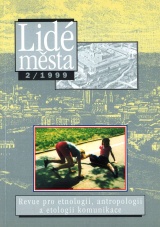Súčasné obytné sídliska na Slovensku
(Na príklade bratislavskej Petržalky)
DOI:
https://doi.org/10.14712/12128112.4016Abstrakt
The social environment of a city is one of the dominant issues of urban ethnology. Differentiation of society, stability and change, tolerance and intolerance, these were the main directions of the research of urban environment in Slovakia in the past decade. Ethnographers are able to provide a thorough description of the life of urban residents in the inter-war period. However, the research usually ends with the year 1948. Analyses of the socialist era are rare in the Slovak urban ethnography. The way of life in urban environments over the past 40 years seems to have become uninteresting, a sort of common knowledge, and if an assessing approach is applied, almost pathological. A special category of urban neighbourhoods of current town is created by housing estates built as a result of socialist town planning since the 1960s. Within a research of residential housing estates it has been proved that the most provocative role is played by the biggest housing estate in Slovakia - Petržalka. With its population of about 130,000 residents it might feature as the third biggest city of Slovakia, after Bratislava and Košice. The housing estate started to be built in the 1970s and the last blocks of flats were put into use in the latter part of the 1980s. The presented study summarises knowledge about neighbourly communication the author collected through her own research and an inquiry conducted in two prefabricated houses in Petržalka. The author arrives at the conclusion that a similar inquiry to that conducted in the environment of the housing estate had been carried out by E. and P. Salners in a locality in central Bratislava. They, too, found that the surviving conclusions about social isolation of individuals and families should be reconsidered. They highlight a group character of contacts (according to sex, age and interests). Adaptation to an environment is connected with emotional attachment and identification with it. In the environment of Petržalka the identification with a residential locality attaches a person to the street and neighbourhood he/she inhabits. Despite a relative satisfaction with housing in the locality under observation, a low attraction of the housing estate as a whole has caused the residents of the observed neighbourhood to identity themselves with Petržalka only in some situations such as when meeting the housing estate's inhabitants outside Bratislava, when waitlng for public transport heading for Petržalka and the like. There is hardly any interest in what happens in other parts of Petržalka, which is reflected in small interest paid to Petržalka's local media, ignorance of street names in other parts of it, and lack of interest in the work of the local town hall if it does not relate directly to the local place. The low identification with Petržalka was also caused by the fact that most of its inhabitants had moved there not because they had selected the place, but because they had no other choice. Since identification with an environment depends on time and generations, the formulatíon of an assessment in relation to Petržalka requires comparison with other housing estates of a similar age.
Stahování
Publikováno
Jak citovat
Číslo
Sekce
Licence

Tato práce je licencována pod Mezinárodní licencí Creative Commons Attribution-NonCommercial-NoDerivatives 4.0.


